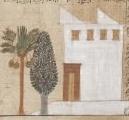The Mayan ballgame has a lot of interesting components to it. The objective of the game is to get rubber balls into stone hoops. The two to five players on each team were only allowed to use their bodies and Monolpa, because hands and feet were not allowed. The Rubber ball was made from the rubber tree. The ball was usually about eight pounds but the size varied from that of a softball to that of a beach ball based on location. The uniform was used for protection but still had to allow fast movement. Many players wore Yogiuto, which are wooden pads worn on the knees possibly to help hit the ball. Cloth yokes were worn for protection around the waist. The Manolpa were stone figures held in the hands of the players and used as a bat to hit the ball. The court was mainly made up of a center playing alley. There were slanted walls along the length of the playing alley with hoops protruding high above the ground. On the remaining sides of the alley there are two end zones that make the court look like an capital I.
The Mayan ballgame was more a religious ritual than a sport. In order to keep balance in the world sometimes a player of the loosing team- which was often war captives- would be sacrificed to the gods. During the game, such as during the half-time, other sacrifices would be made to the gods like maize or the sap of the copal tree. Before and after the ballgame the players would dress in stone yokes for ceremonies. They would fasten Hacha onto their yokes. Hahca are stone figures made for ceremonies. The courts were also painted brightly with scenes of sacrifice to the gods and the power of the local ruler. Songs of honor to the gods were played before and after the game along with during the halftime.

